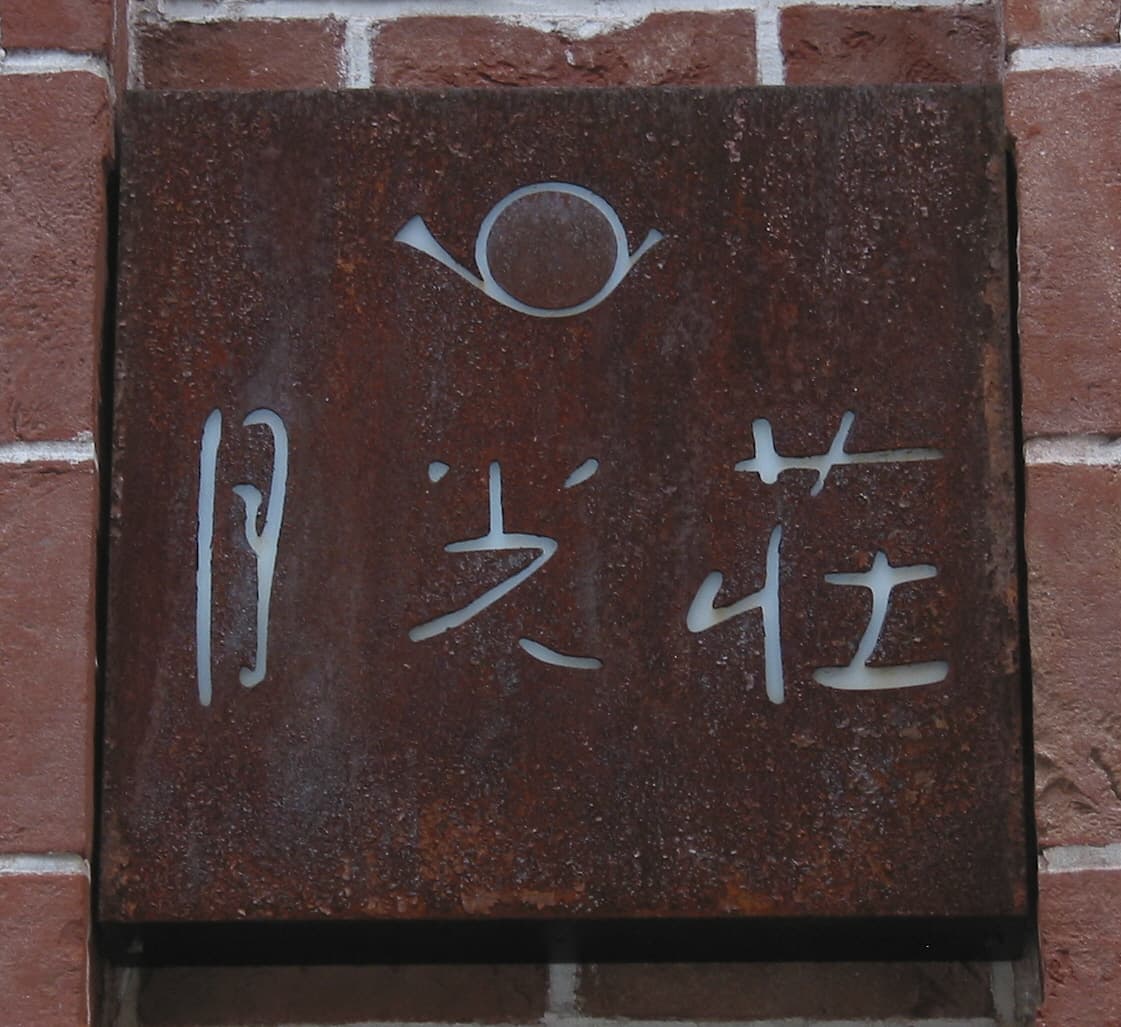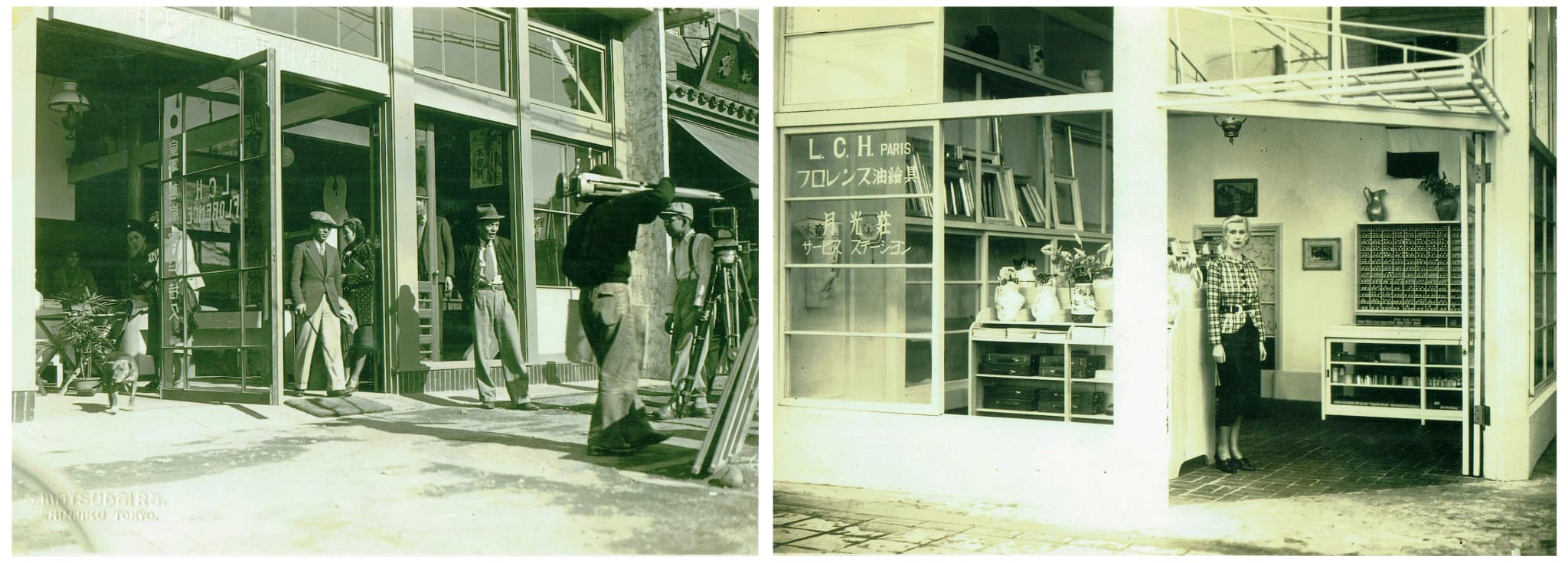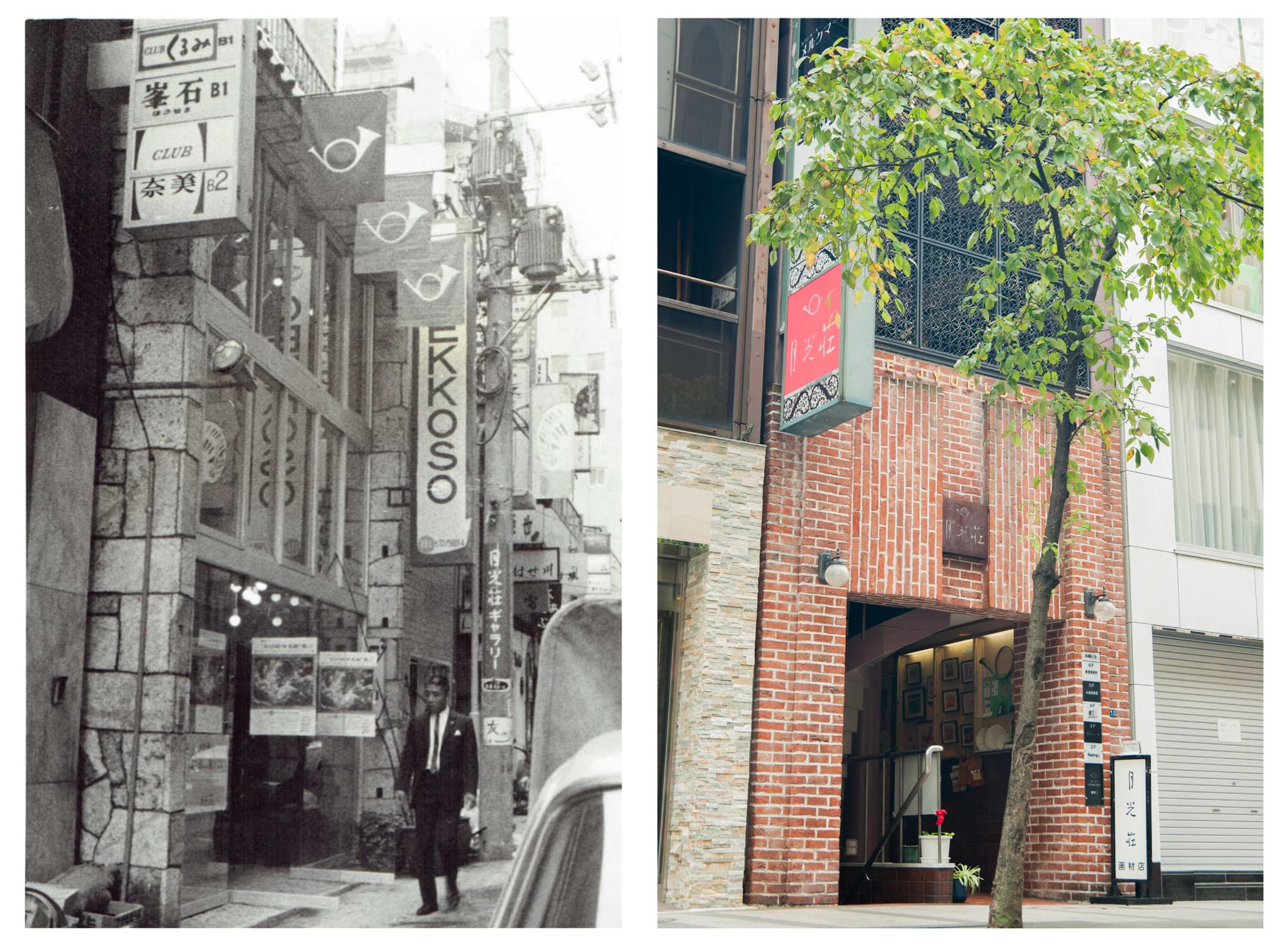Founding Story

About the founder
Hyozo Hashimoto, the founder of Gekkosou Art Supplies Store, was born in 1894 in Toyama, and grew up in a town rich in nature where the melting snow from the Northern Alps flows into the Sea of Japan.
Hyouzo's father was the kind of person who would advise the pilgrims to take the fruit that is within reach of the persimmon tree, and the fruit from the top to the birds, and you should only take the fruit in the middle and eat it. It is said that he repeatedly reminded Hyouzo of the importance of people and animals helping each other to survive in the wild.
He also believed that a learning environment was important for children, so he bought books one after another and piled them up in the storehouse. This was a so-called silent education, and Hyozo was able to grow up reading a lot of books. There are words that Hyozo's father has said to him so many times that he has calluses in his ears ever since he could remember.
"1. Don't lie. 2. Don't steal. 3. Work hard. If you can do this, you're half a man. On top of that, if you can give back to others, you're a full man."
It is said that Hyouzou's mother was also a compassionate person who was not concerned about our family's poverty and would take rice cakes from her own to even poorer neighboring families.
Although his educational background was only in elementary school, Hyozō was raised by strict but warm parents and developed a free spirit, and his heart fluttered as he ran around the mountains and fields, admiring the beauty of the flowers. I also love watching rainbows in the sky, and one day I was so fascinated by the beauty of nature that I said, ``I want to cross that rainbow bridge!'' despite the restraints of my school teacher. It was attached.

Birth of Gekkoso
Hyozo spent an impressionable childhood in an environment rich in nature, and eventually came to admire Tokyo, and moved from Toyama to Tokyo in 1912 at the age of 18. While working as a postman and other jobs, he began working as a live-in student at the Kudan house of Mr. Fisher, who was the manager of the YMCA. The house across the street at that time was the home of poet Tetsukan Yosano and his wife Akiko.
Hyozo, who has been reading the Yosano couple's poetry collection for some time, is excited about meeting them even if it's only once, and one day he finally decides to visit them alone. When a young man who was completely out of the country suddenly came to visit, the couple welcomed him in without a single unpleasant look on their faces. He took a liking to Hyozo and not only asked me to come visit him anytime, but he also introduced me to the guests who gathered at Yosanoya from time to time.
At the time, the couple was running the magazine Myojo, and their home included poets such as Hakushu Kitahara, Takuboku Ishikawa, and Kotaro Takamura, painters such as Takeji Fujishima, Ryuzaburo Umehara, Ikuma Arishima, and Saburosuke Okada, as well as architects. People from different genres gathered together, including families and Kabuki actors.
At the couple's house, Hyouzo was unable to have any witty conversations and just listened silently to what everyone was saying, but he gradually came to be loved by the people who gathered, and eventually The world of art, which he had never known before, began to unfold in Hyouzo's mind. I am captivated by what painters talk about, such as the ``eye for seeing things'' and ``the heart for expressing things.''
It is said that a young man who had always been reserved once took the plunge and told his painter teachers how much he admired the rainbows he saw in the town where he was born and raised when he was a child. I managed to join the group of these fascinating artists, and before I knew it, I was wondering if there was something I could do to help them.
Everyone starts giving him advice.
``Since you have an admiration for color and a good sense and sensibility, why don't you try doing a job related to color?''
Hyozo knew that painters were very dissatisfied with the paints and art materials sold in Japan. It was at that moment that I clearly saw the path I wanted to take in life: to become an art supplies dealer. In his later years, Hyouzo described his feelings at this time as follows:
``I have made a firm decision to spend my life helping teachers who are pouring their hearts and souls into something as big as art.''
Hyozo first began importing paints from foreign countries. When I received an order for art supplies, I delivered them by bicycle, just like I did when I was a postman, even on rainy and windy days. Eventually, funds were saved, and in 1917, the Tokyo new
The first Gekkosou art supplies store opens at the corner of the inn. Hyozo Hashimoto was 23 years old.
When it was time to open the shop, Hyozo received a song from Akiko Yosano.
"From the moon in the sky comes the prince, and the night that does not shine does not shine."
Mr. Tekkan named it ``Gekkosou'', a quote from the French poem ``Moonlight and People'' by Verlaine. The words "Gekkosou" written on the signboard at the entrance of the current store are also handwritten by Akiko Yosano.
In order to never forget the kindness of Mr. and Mrs. Yosano throughout his life, Hyouzo began to call himself ``Gekkosou Oyaji''. From then on, all mail was addressed to "Gekkoso Oyaji" and "Gekkoso Ojisan."
In addition, the trademark "horn that calls friends" was also used by a group of cultural figures of the time centered around the Yosano couple (Kaoru Koyamauchi, Ryunosuke Akutagawa, Toson Shimazaki, Takeo Arishima, Ennosuke I, Ritsuko Mori, Takeji Fujishima, Saburosuke Okada). It was devised by over 30 people, including 30 people, with the hope that many people would gather together through the sound of music. How impressed Hyouzo must have been!
The architectural design of the store was supervised by painter Tsuguharu Fujita, and it was a novel structure at the time, looking like it was taken directly from a street corner in Paris, and because of its unusual architecture, it was used as a location for various movies. There was also a tall French woman working at the store, and she seemed to have a very stylish appearance for the time.

When the company was founded
Akiko Yosano was worried about her financial situation after starting her own business, so she gave Hyōzo a business card with the words ``My Friend'' written on it, and asked Aizō Soma, the owner of Shinjuku Nakamuraya, who was originally from Toyama and founded Fuji Bank, to take over her business card. We will introduce them to Zenjiro Yasuda, the founder of a consumer cooperative, and Toyohiko Kagawa, the founder of a consumer cooperative, to help them learn the basics of business management.
“Rather than thinking about what will sell, sell what makes people happy.”
``Make what you sell by yourself, and only sell things you are confident in. And don't sell cheaply by cutting the price just to sell.An artist who jumps to paint like that will never become successful.No matter when. But don't be a slave to money.
Gekkosou was started with advice from senior managers.
Gekkosou Oyaji continued to deliver art supplies even while owning a shop. The purpose is to show how painters actually use art materials, and to continue making improvements through repeated research. It is said that he visited the ateliers of young artists such as Kazumasa Nakagawa, Ryohei Koiso, Genichiro Inokuma, Toshio Nakanishi, and Kazu Wakita almost every day.
After about five or six years of opening, the store gradually started to take off, and became a salon-like place where cultural figures of the time, led by Mr. and Mrs. Yosano, gathered.
Development of purely domestic paints
When Gekkosou was founded in the early 20th century, Japan's Western painting industry was trying to catch up and surpass France, and when it came to paints, they had no choice but to rely on French ones. Gekkosou had not yet developed its own paints, and at the time Gekkosou was the only company in Japan to sell French-made LCH PARIS, as well as Florence oil paints and other imported products.
In those days, importing was by sea, so it took at least two months for it to arrive, and not only was it expensive, but paints were never easy to obtain, as artists often didn't have the colors they wanted when they wanted to use them. was. Also, at that time, there were some domestically produced paints, but they were simply kneaded dye powders imported from Europe, which had many impurities and the quality could not be compared to imported paints made from pigments.
Under such circumstances, Hyozo felt a sense of duty to create genuine, domestically produced, brightly colored paints that painters who dedicated their lives to creating their works could be proud of, and he began developing his own paints. .
When the war began, imports from foreign countries ceased, so the Ministry of Education ordered companies to manufacture substitute paints. Everyone in the industry agreed, and the age of substitutes began. However, Hyozo was the only one who opposed the use of substitutes and insisted on making real paints, believing that it is the artist's job to never repaint a picture.
When painters gather together, you can hear them wishing for the production of domestically produced paints as soon as possible. Even if it was widely criticized, in order to compete with British and French products, it was necessary to make homemade pigments. During the war, cobalt was an essential metal for refining special steel, and was also an extremely important ingredient for military purposes. At the same time as the war began, the Japanese government at the time allocated a large budget and ordered research laboratories at various universities to develop cobalt. However, no matter how many years pass, it is still not completed.
Under such circumstances, Hyozo's first project was ``Cobalt Blue''. The pigments used in paints are made from the ingredients extracted from raw minerals that are fired at high temperatures. Since Hyozo didn't have any specialized knowledge, he read every technical book he could find and experimented repeatedly trying to figure out how to extract the blue cobalt component from the mineral raw material.
Pick up the stones from the riverbed,
Crush and bake;
Crush it again and repeat.
Even when baking, it was a process of trial and error, wondering what would happen at thousands of degrees and how much time would be best. With a strong desire to help painters no matter what, he continued his research without giving up, and as a result, the ore, which had been slowly baked using a unique technique, finally glowed blue in the furnace. In 1940, the moment when cobalt blue pigment was successfully extracted. It is said that he came up with a method to extract cobalt from a geyser he happened to see blowing up.
In this way, Japan's first completely domestically produced oil paint made from pigments was completed. It was 23 years after I founded Gekkosou Art Supply Store.
Genichiro Inokuma, a Western-style painter, was delighted with the completion of this purely domestic paint, and immediately went around reporting the birth of cobalt blue to various newspapers, but it did not even get a single article. The country's reputation would be ruined if something that could not be completed in the laboratories of top universities, where the government invested vast amounts of research funds, was completed in small factories. On the contrary, there were even rumors such as, ``There's no way a small factory could do this; it must have been importing and stockpiling before the war, and then gradually dispensing it.'' Hearing such a voice, Hyozo gets angry and declares.
“In that case, even through the Art Federation,
Try ordering a lot at once.
I'll give you hundreds of dozen. ”
Eventually, an order was received from the Army saying, ``If you really have cobalt, submit it.'' Hyozo rejected this military offer. The next day, we receive a request from the Navy Department. Cobalt was said to be important for the military, but they decided to provide it only as a paint for paintings. Because of this background, all of the so-called "war paintings" used only Gekkosou paints. Although war is a tragedy that should never happen again, the colors of war paintings still shine brightly.
After the war, paint development research continued, and in 1948 they invented SOS (paste-like quick-drying agent), and in 1952 they succeeded in producing titanium white. Cobalt Violet Gekkoso called "Gekkoso Pink" in 1960 Invents Pink (cobalt violet pink). Gekkosou Pink won first place in the 1971 World Paint Contest, and was praised by Le Monde as ``a miracle created outside of France.''
Other activities
At the beginning of the Showa era, Hyozo took the lead in publishing the magazine ``Gekkoso Newsletter,'' which featured a color photo on the cover, which was still rare at the time. It played a major role in deepening exchanges between painters, and even after the Showa era began, the magazine ``Yoga Shinpo'', which combined both ``Western movies'' and ``Western paintings'', which I loved, followed by the magazine ``Modern Landscape''. ” will be launched. After the war, people printed products and news on large sheets of paper and created what they called ``readable wrapping paper.'' Making magazines is a cigarette It was an irreplaceable pleasure for Gekkosou Oyaji, who never smoked alcoholic beverages and lived strictly with only a bottle of Choshi for evening drinks.
In addition, around 1945, a gallery was opened as a place for emerging artists to present their works, and the ``Florence Prize Newcomer Contest'' was held with Saburosuke Okada as the judge. This philosophy of nurturing new artists continues to underlie the current management of Gekkoso Art Studio.
After the war, to Ginza
All of the shops in Shinjuku were reduced to ashes in the great air raids of 1945, and the utopia for painters that he had created in the mountains of Unazuki Onsen in his hometown of Toyama was destroyed in the post-war fire, and Hyozo became truly naked. . After the end of the war, in 1948, the store reopened in front of Taimei Elementary School in Ginza, Tokyo. ``If you're going to do it, Ginza is the best.'' Genichiro Inokuma recommended Ginza, and he jokingly encouraged Hyozo by saying, ``Oyaji, I'm glad you got burned.'' Since then, we have moved several times within Ginza, and since 2006 we have been welcoming customers to our location along Hanatsubaki Street in Ginza 8-chome.

About the future of Gekkoso
Gekkoso started out as Akiko Yosano's salon in 1919. It has been operated based on the philosophy that "color and pitch are the treasures of life."
Now that Gekkoso is celebrating its 100th anniversary, new friends have joined the group. ``Gekkosou Salon Tsuki no Hanare'' where modern sensitive people gather and talk with live music every night, ``Machi Enogu'', a watercolor paint shop in Nagano Prefecture, and Haruzo Nagasaki, a pioneer in the development of Japanese paints. This is ``Shunzo Paint'', which inherits the technology and spirit.
For the next 100 years, as a place where people gather, exchange thoughts, and grow together, we hope that the Gekkoso Group will freely thread the threads of sensibility and propose the richness of a new era. I am thinking.
